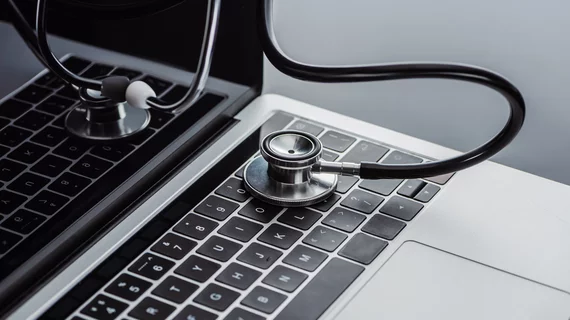Big-name teleradiology firm vRad said it’s seen a notable uptick in computed tomography utilization in the month of March as the number of U.S. cases of coronavirus has picked up. And experts from the Minnesota-based firm are urging peers to be cautious in citing COVID-19 in reporting, given certain economic implications.
Chief Medical Officer Benjamin Strong, MD, said the surge is no surprise, given the scarcity of testing kits, and some studies claiming chest CT yields higher sensitivity than lab-based methods.
Over the past year or so, vRad’s percentage of total cases, across all modalities, that used chest CT sat at about 3.8%. However, this month, the number has swung upward past 4% and reached as high as 5.15% in March, officials shared. Average overall daily demand, meanwhile, has dipped by 8% in mid-March, likely driven down by patients staying home and calls from the Centers for Disease Control and Prevention and others to put off nonurgent imaging.
Late last month, vRad radiologist Greg Klisch was credited with accurately interpreting chest CT images to diagnose coronavirus, which scientists later confirmed with lab tests. Despite that success, Strong echoed concerns voiced by the American College of Radiology and others that physicians should not use CT as a first-line diagnostic tool during the pandemic.
“I’m in agreement,” he told Radiology Business. “My gut tells me that the test will always be the definitive diagnostic because it is, in fact, specific. I would like to see efforts centered around better, more accurate and more accessible testing. I think everyone with the viral syndrome getting a chest CT could overwhelm the nation’s imaging infrastructure, quite honestly, since we’re already strapped nationwide from a radiology standpoint.”
He added that until kits are more prevalent, “in the absence of testing, I don’t know what else you can do. It certainly is better than nothing. In that case, chest CT probably will be the primary diagnostic.” At the same time, Strong also acknowledged that such imaging findings are “extremely nonspecific and overcalling those is a clear and obvious risk.”
Virtual Radiologic is based in Eden Prairie, Minnesota, and is part of the larger Mednax. VRad, as it’s called for short, deploys some 500 board-certified or eligible physicians in the U.S. In most coronavirus cases vRad has seen, Strong said, the firm’s remote radiologists are typically sent images from emergency departments across the country that don’t have an in-house image reader at hand after hours.
He estimated last week in just two days, vRad doctors read nearly 800 cases for viral pneumonia, but said it’s difficult to specify how many were actually COVID-19. He expected that number to swing upward in the coming weeks as case numbers grow.
One piece of advice he had for radiologist facing the disease is to not get too specific in reporting, unless you’re absolutely certain. Strong said there’s been widespread agreement on this issue among the imaging community.
“There are economic implications centering around the reporting aspect of this,” he told Radiology Business. “There is an underlying philosophy behind not saying ‘COVID-19’ in every case. We can’t be that specific and if we start saying ‘COVID-19’ on every chest CT report, that frequently will kick off decontamination protocols that are quite extensive and expensive, and honestly help to feed any hysteria or panic that might be developing. It’s an efficiency detriment for the onsite practices that have to shut their scanners down and slow their throughput, just at a time when they may want more access to those resources.”

